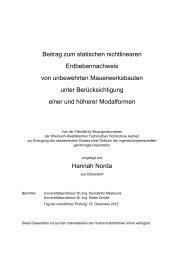Ion Beam Treatment of Functional Layers in Thin-Film Silicon Solar ...
Ion Beam Treatment of Functional Layers in Thin-Film Silicon Solar ...
Ion Beam Treatment of Functional Layers in Thin-Film Silicon Solar ...
Create successful ePaper yourself
Turn your PDF publications into a flip-book with our unique Google optimized e-Paper software.
5.2 Reason <strong>of</strong> rough growth<br />
ion beam treatment are not persistent with acidic solution. The observations give a h<strong>in</strong>t<br />
to explore the reason <strong>of</strong> the rough growth.<br />
5.2.3 Sputter ZnO:Al film <strong>in</strong> different system<br />
In the previous sections the glass substrates were changed or modified by post-clean<strong>in</strong>g<br />
process. This section exam<strong>in</strong>es the growth <strong>of</strong> ZnO:Al film <strong>in</strong> other sputter<strong>in</strong>g systems.<br />
In our <strong>in</strong>stitute, apart from the large area planar target, small area round target, tube<br />
ceramic target, and tube metallic target are available as <strong>in</strong>troduced <strong>in</strong> Section 3.1.1.<br />
As for the large area planar target, a sputter<strong>in</strong>g area <strong>of</strong> 30 × 30 cm 2 is possible, while<br />
sputter<strong>in</strong>g area <strong>of</strong> 10 × 10 cm 2 is considered <strong>in</strong> small area sputter<strong>in</strong>g system. The new<br />
<strong>in</strong>stalled tube target benefits from its high target material utilization and high sputter<strong>in</strong>g<br />
rate. Sputter<strong>in</strong>g process has been optimized at high rate sputter<strong>in</strong>g for Si th<strong>in</strong>-film solar<br />
cells.<br />
In this experiment, Corn<strong>in</strong>g glass substrates were pretreated by mixed Ar/O 2 ion<br />
beam under the same condition. Then the glass substrates were transfered to different<br />
ZnO:Al sputter<strong>in</strong>g system. ZnO:Al films around 800 nm were sputtered <strong>in</strong> all systems.<br />
In each sputter<strong>in</strong>g system, an untreated glass substrate was added as reference. F<strong>in</strong>ally,<br />
the ZnO:Al films were characterized by AFM and 4-po<strong>in</strong>t measurement.<br />
The characterization <strong>of</strong> the ZnO:Al films grown <strong>in</strong> the four sputter<strong>in</strong>g systems are<br />
listed <strong>in</strong> Fig. 5.15. The scan size <strong>of</strong> AFM measurement for all samples is 4 × 4 µm 2 .<br />
The sheet resistance and rms roughness <strong>of</strong> each sample are marked on the right <strong>of</strong> the<br />
AFM images. For all the samples, with ion beam pretreatment, higher resistance and<br />
larger roughness <strong>of</strong> ZnO:Al films are observed, even though the topographies <strong>of</strong> ZnO:Al<br />
film grown <strong>in</strong> various system differ from each other.<br />
The rough growth <strong>of</strong> ZnO:Al films on Ar/O 2 treated glass substrates is a universal<br />
effect <strong>in</strong> different sputter<strong>in</strong>g system. Based on this results, the as-grown rough ZnO:Al<br />
films might be possible to transfer to other sputter<strong>in</strong>g system, for <strong>in</strong>stance for <strong>in</strong>dustrial<br />
process.<br />
5.2.4 Sputter ZnO:Al film with different temperature<br />
This section exam<strong>in</strong>es the rough growth <strong>of</strong> ZnO:Al films <strong>in</strong> the standard sputter<strong>in</strong>g<br />
system with different sputter<strong>in</strong>g parameters. As <strong>in</strong>troduced by the modified Thorntonmodel<br />
<strong>in</strong> Section 2.2.4.3, the growth <strong>of</strong> ZnO:Al films depend on the substrate temperature<br />
and sputter<strong>in</strong>g pressure. In this section, the deposition temperature was varied<br />
to <strong>in</strong>crease the roughness further, while keep<strong>in</strong>g the sheet resistance and total transmittance<br />
<strong>in</strong> a moderate range. Three different heater temperatures were applied dur<strong>in</strong>g the<br />
ZnO:Al deposition. The topography and sheet resistance <strong>of</strong> the ZnO:Al films change with<br />
temperature. On an untreated glass substrate, the ZnO:Al films change from crater-like<br />
to pyramid-like feature with decreased compactness as shown <strong>in</strong> Fig. 2.11 when the temperature<br />
decreases. The <strong>in</strong>fluence <strong>of</strong> the rough growth by decreas<strong>in</strong>g the temperature<br />
is <strong>in</strong>terested s<strong>in</strong>ce as-grown rough ZnO:Al films have already pyramide-like features and<br />
lower compactness.<br />
95















